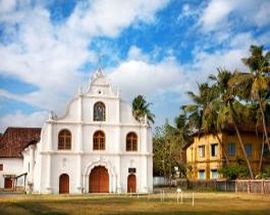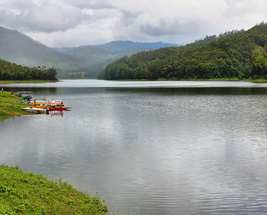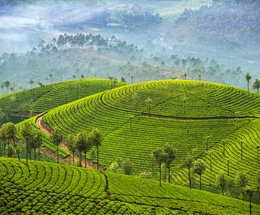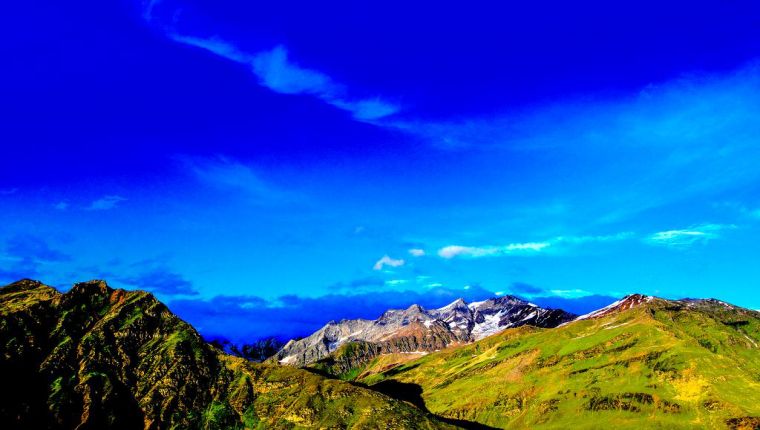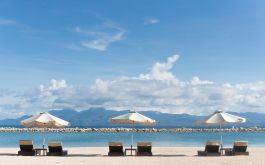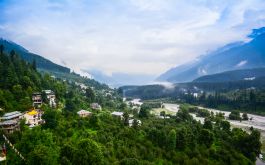Best time to visit India
The medley of seasons in India has been the source of inspiration for storytellers and poets alike, providing breathtaking backdrops to many a drama and romances. As per the traditional lunisolar calendar, there are six seasons in India - Vasant (Spring), Greeshma (Summer), Varsha (Monsoon), Sharad (Autumn), Hemant (Pre-Winter) and Shishir (Winter). However, for travel purposes, let’s focus on Winter, Spring, Summer and Monsoon.
Geography of India
Understanding the location and topography of India becalms curious minds that wonder ‘why so many seasons’? Landmass bisected by the Tropic of Cancer explains the hot, humid and tropical tag that India has garnered. As much fun as the beaches are, when you have a coastline of 7516.6 km, you bear the brunt of both the northwest and the southwest monsoons. Good thing is that Indians love rains and will make sure that you enjoy them too. The snow-capped arc of 2,500 km long Himalayan mountain range towers over the entire north and northeastern part of India. What an absolute contrast to the western miles of arid sand dunes of the Thar Desert! It is a privilege to experience such geographical diversity in one single trip.
Climate of India
The alchemy of India’s various climatic subtypes makes sure that you are never too far from your choice of ambience. From skiing in the alpine tundra mountains to desert night camps or whisking your loved one to a cosy hideaway in the tropical rainforests, all is possible once you are here. The Western Coast and Ghats have a tropical rainy climate. The desert winds of Rajasthan and Kutch dance to the sub-tropical arid climate. Most of the Gangetic plains and large parts of Deccan Plateau have a semi-arid savannah climate with hot summers and ample monsoon.
Here are some pointers that will help you read India’s seasons like an open book.
Peak Season – November to February
Shoulder Season – March to May and October
Low Season – June to September
|
Travel Seasons
|
Average Temperature
|
Season
|
|
November to February
|
16-20°C in South India
-3 to 20°C in Northern Plains
10 to 25°C in Western India
Up to -30°C in Ladakh and other alpine regions
|
Winter
Dry and Cool
Cold and foggy with intermittent rains
Dry and Cool
Extremely cold and snowy
|
|
March to May
|
16°C to 50°C
|
Summer
Hot and dry in the plains
Hot and humid along the coasts
|
|
June to August
|
Max. temp. rang 26°C to 34°C
Min. temp. range 14°C to 20°C.
|
Monsoon
Rains, Thunderstorms
|
|
September to November
|
Max. temp. range 28°C to 34°C
|
Autumn
Clear sunny skies
|
India in Winter (November to February)
If it is the soft crackle of firewood and windblown snowflakes you seek, after a fine day on the ski slopes, then this is the time to visit India. It also happens to be the best time to hit the sun-kissed beaches. A poetry in contrast!
Temperature
South India and the entire coastline remains pleasant with a minimum temperature of 16°C and a maximum of 20°C. The Northern Plains can get freezing cold up to -3°C at night. There is a change of 0.6°C per degree of latitude. Some tourist places such as Ladakh experience a sub-zero shiver of up to -30°C.
Weather
December and January are the coldest months across all terrains. The Himalayas keep the katabatic winds away from India thereby keeping the peninsula comparatively warmer than other continents.
Significance
Winter is cherished all across India as the season to celebrate. Most of the religious festivals and auspicious celebrations rest in the cosy lap of these four months.
Why visit now
- From transport to food and accommodation, everything is at its functioning best as this is the peak tourist season
- You get to celebrate major festivals such as Diwali, Christmas, New Year, Losar and many other specially curated attractions
- Winter Himalayan treks are spectacular and less crowded
Things to know before the visit
- Alternate transport options if traveling to remote locations
- What to wear in different regions as there is a huge difference in temperatures
- Location of nearby foreign currency exchange offices
Travel tips
- It is advisable to book your tickets much in advance to avoid last minute rush
- If visiting hill stations, keep an eye out for local news on road clearances
- All adventure sports must be undertaken with certified operators
India in Summer (March to May)
It is a season that Indians look at with mixed emotions. Summer starts with a short and early spring season. The scorching afternoons make you want to stay indoors but the call of gushing waterfalls and bluebell meadows are irresistible.
Temperature
In South India, western deserts and northern plains the temperature ranges from a slightly bearable 30°C to an unforgiving 50°C. In Himalayan foothills and alpine regions the temperature ranges from 16°C to 30C.
Weather
Summer begins early in March across India except the northwestern regions where it starts from April. This makes April the hottest month in South whereas May is the hottest month in North.
Significance
You can get a lot done from daybreak to dusk as the days are long. Mornings are delightfully cool to step out to begin early explorations.
Why visit now
- The crowds have thinned out
- Spring/early summer are the prime seasons to visit hill stations and valleys
- Wildlife sightings and safaris are a sure success
Things to know before the visit
School summer holidays mean there will be a lot of children anywhere you go. Get ready for some high-energy surround sound on your travels
The exact route and assistance service station details for your road trip
Travel tips
- Keep drinking sips of water at regular intervals
- This is rush time on the hills; book your tickets, transport and activities much ahead of time
- Cover yourself well if you intend to stay in the sun for a while
- Keep your allergy medicines handy if spring pollens bother you
India in Monsoon (June to August)
Temperature
The maximum temperature ranges from 26°C to 34°C. The minimum temperature ranges from 14°C to 20°C. Northern plains have temperatures ranging from 26°C to 34°C whereas Himalayan foothills experience a cooler monsoon with 15°C to 20°C.
Weather
Heavy rains and thunderstorms are a norm. Some Terai regions experience only the afternoon showers.
Significance
Unlike other countries where rain is dreaded, India loves its monsoon season. Having been an agrarian society, Indians have depended on rainfall for a good crop for ages. It signifies life, fertility and prosperity. Rain is an important part of almost all rituals of cultural importance.
Why visit now
Thin crowds at all major tourist spots, waterfalls and rivers in their prime, unhurried hospitality and waking up to clouds piling up over verdant landscapes. Want more reasons? Here’s one you simply cannot resist - great discounts on hotel tariffs and airfare!
Rejoice and join in the revelry of important Indian festivals such as Ganesh Chaturthi, Hemis Festival, Jagannath Rath yatra, Onam, Janamashtami, Sao Joao and many more
Things to know before the visit
- National Parks and Wildlife Sanctuaries remain shut
- Local guides may not be around so be prepared to explore the destination with the help of residents and books
- If you keep a track of how monsoon breaks in India you can beat it by being one step ahead at the chase
Travel tips
- Carry raincoats and umbrellas everywhere. Clear skies love to follow Murphy’s Law in this season
- Invest in waterproof shoes with a good grip.
- Keep a waterproof case handy for your gadgets.
- Buffer up the travel time. Traffic snarls are a stark reality at this time of the year.
- Be extremely cautious while walking on waterlogged roads in the cities.
India in Autumn – Fall in love (September to November)
Temperature
The average maximum temperatures ranges between 28°C to 34°C.
Weather
Diurnal temperature swings make the days warm and the nights nippy. The retreating northeast monsoon results in clear skies and sunny days.
Significance
It is the season that drumrolls the beginning of festivities. Preparations for all major festivals start now.
Why should you visit now
- You’ll get to shake a leg at the dandiya dance at Navratri festivals and watch the magnificent Dushera/ Durga Puja processions.
- It is your last chance to catch high-octane river rafting expeditions or high-altitude road trips before they close down for winters.
- Hill stations are aglow with heavenly fall colours and a feast of berries.
Things to know before the visit
- October heat is unforgiving at many destinations as it is coupled with high humidity.
- The tourist season is just beginning so getting an early start on your travel ensures that you get the best of everything.
- Walk into any shop and you will be greeted with the latest in fashion and trends as fresh stock arrives now, just ahead of the festive season.
Travel tips
- Keep yourself covered from the sun and remain hydrated.
- Look out for discounts on hotels and flights.


